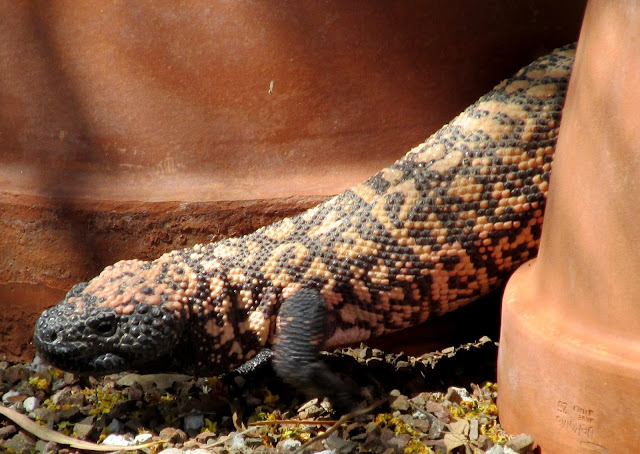The Legendary Gila Monster, that almost mythical creature of the Wild West, about whom tall tales are told, about whom superstition and myths abound. And yet, here he is, right in my back yard. I consider myself among the lucky ones who have actually seen a Gila monster in the wild. Some people live their entire lives in the Sonoran Desert and never encounter this fascinating creature.
Even the name, 'monster', is absurd and reflects the amount of misinformation and exaggeration about a lizard that is barely two-feet long, slow and lumbering, shy and non-aggressive. Perhaps it's the elusive nature of a creature that spends 90% or more of its life underground, hidden from view, and about which, as a result, not a lot is known.
The Gila monster is one of only two venomous lizards in North America, and the only one in the U.S. The other, the Mexican beaded lizard, lives exclusively south of our border, in Mexico and into Guatemala. Gila monsters are known as nest raiders, and since they prey almost exclusively on food that will not run away from them - baby rabbits, bird eggs, baby lizards - their venom is not needed to subdue prey as is the venom of rattlesnakes, for instance. So, what's the purpose of the venom? Defensive? It seems the most logical. The venom gland is located in the lower jaw, and travels through the grooved lower teeth to enter the victim, producing excruciating pain. Just in case you were thinking of getting away after being bitten, the Gila monster's other trick is to not let go, continuing to gnaw, increasing the venom delivery and making sure you are plenty sorry you harassed him. Not to worry, however, you won't die from the venom. And that's the good news. The bad news is that you'll probably wish you would!
The beautiful black and orange/pink beaded pattern is unique to each individual lizard. The genus name, Heloderma, means studded skin. The 'beads' are actually bony scales, making the lizard's skin extremely difficult to penetrate and providing a good defense against large predators such as coyotes. Two subspecies differ in the beading patterns - banded, with regular, well-defined bands all over; and reticulated, with the irregular pattern such as the one shown in the photo. The reticulated is the species of southern Arizona and the only one I've ever seen. Oddly enough, all newly hatched Gila monsters are banded, but the ones in our range (Heloderma suspectum suspectum) develop the reticulated pattern as they mature. The small western banded gecko is sometimes mistaken for a baby Gila monster.
A forked tongue, like that of snakes, gives the Gila monster an extremely good sense of smell, and allows it to locate even buried eggs. Emerging from the winter den in spring, the Gila monster goes looking for food, and may gorge itself when food is available, storing fat in the tail for the long, lean months ahead. A mate is also on the agenda, and, if that quest is successful, the female lays eggs in July or August, burying them in the sand. The eggs overwinter and hatch in the spring.
In recent years, research on Gila monster venom has led to the development of exenatide, a drug that is a synthetic form of a substance found in Gila monster saliva, for the treatment of Type II diabetes. It helps control blood sugar levels and leads to weight loss.
Many years ago, we named a visiting Gila monster Albert. Since then, every one who comes to our yard is known as Albert. I suppose it would be possible to compare photos and see if Albert is one individual or many different ones. I prefer the mystery. See you again next year, Albert.
The End




What a marvelous post about a fascinating animal. Thanks for posting.
ReplyDeleteIt's been years since I've seen a Gila monster. Albert is so handsome, terrific post!
ReplyDeleteHello, They are neat lizards. I would love to see one in person some day. great post and photos. Happy Thursday, enjoy your day and weekend!
ReplyDelete